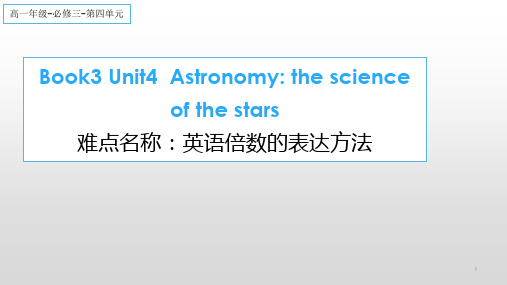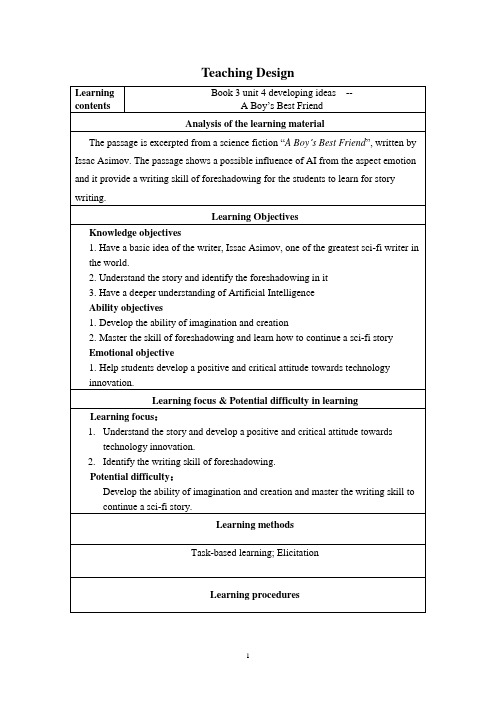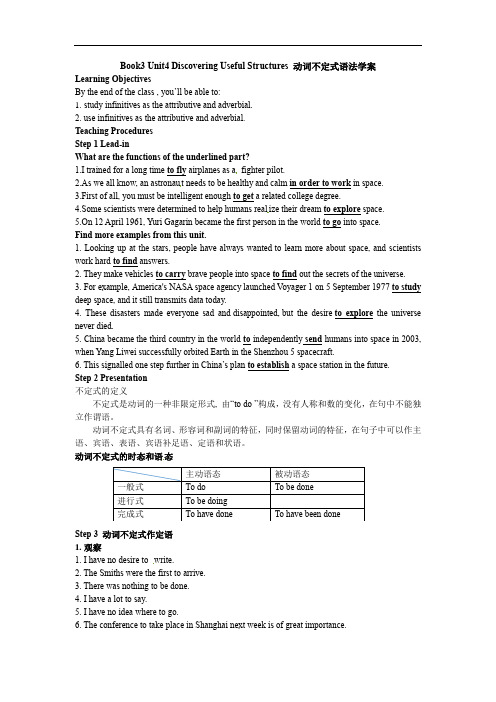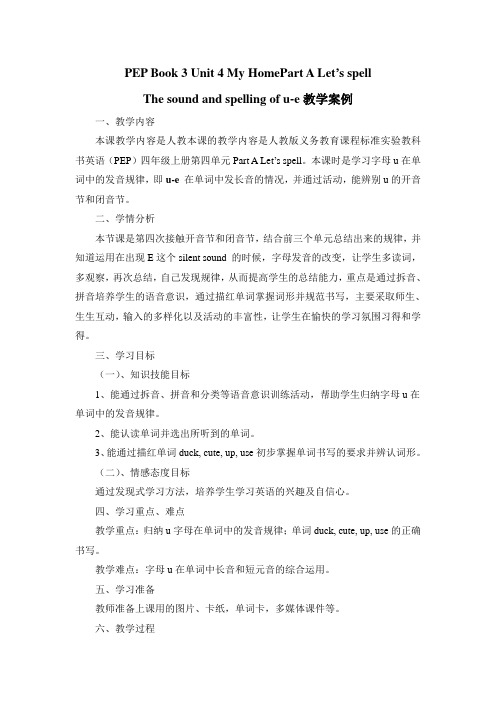Book3 Unit4全单元教案
人教新课标 高一英语Book 3 unit 4 英语倍数的表达方法 课件

3.“A + be + 倍数 + the + 计量名词 + of + B ”
The newly broadened square is four times the size of the previous one. 新扩建的广场是未扩建时的四倍大。
计量名词 :size大, length长, width宽, height高, depth深,weight重
2.“A + be + 倍数 + 形容词或副词的比较级 + than + B”
The Yangtze River is almost twice longer than the Pearl River. 长江差不多比珠江长两倍。 The dictionary is exactly five times more expensive than that one. 这本字典比那本恰好贵5倍。
normal price here. 这里名牌衣服的售价经常比正常的售价高一倍。 I'm twice/ double his age. 我的年龄是他的两倍。
Practice
翻译下列句子
1.这块大石头的重量是那块的三倍。
This big stone is three times as heavy as that one.
6. “ A + be +倍数+as many(或much)+名词+其 他+as… ”
倍数的其他表达方法:
1.用分数、百分数表示倍数 2.用 again (一倍), double (两倍), triple (三倍), fourfold (四倍)等词表示倍数。
人教版三年级下册英语Unit 4教案

Unit 4Where is my car?单元教材及学情分析1.单元教材分析本单元的学习围绕一个游戏展开,讲的是几个小朋友在玩我藏你猜的游戏,并由这个游戏引出要学的介词in, on, under。
同学之间玩这个游戏,分别说出物品的具体位置。
如:in the desk, on the chair,并引出问句:Where is…?用英语和自己的小伙伴玩捉迷藏的游戏,对学生来说充满了乐趣。
本课学习的知识点接近实际生活,能够调动学生学习的积极性,有利于教师教学活动的开展。
在Part A中主要讲张鹏和约翰放学后收拾书包的情景。
运用表演的方式能更加自然地呈现句子和单词,目的是让学生明白在我们的实际生活中也可以运用同样的对话来交流,创设学生运用英语的场景,让学生在日常生活中能够做到多运用,多练习,达到掌握第二语言的目的。
在Part B部分,课文以一个小男孩寻找东西并问妈妈的故事开头,比较接近学生的实际生活。
妈妈给他指的几个方位也是学生最容易忘记的地方。
在Part C部分运用学生比较感兴趣的动物对话的方式提高学生学习的兴趣。
2.学情分析教材中出现的主人公是学生在之前的学习中已经熟知的人物,内容也是学生喜欢的。
这让学生感觉到教材有连续性,对学生感知故事情节,理解故事内容很有利。
教学中将重点放在让学生在情景中体验对话,多说多听,以生生互动的形式让学生体验开口说英语的乐趣,从而达到灵活运用的目的。
单元教学目标1.知识目标(1)能够听懂、会说句型:Where is…? It's in/on/under… Is it in/on/under…?Yes, it is./ No, it isn't.(2)能够听、说、认读单词:desk, chair, in, on, under, cap, ball, car, boat, map。
(3)知道元音字母o在单词中的发音。
2.能力目标(1)能够在图片、实物或情景的帮助下运用句型Where is…? It's in/on/under…来询问物品位置并回答。
大学英语Book3 unit4 教案

工业学院教案Unit 4说写课(第1次课)The first 50 minutes:Step1: Pre-reading activities. (15 minutes)1.Students listen to the introduction about Xi’an and then do the pre-readingactivities on page 92 (group work and discussion).Step 2: Text A reading comprehension.1.Ask the students to read Text A within 15 minutes and raise questions about textunderstanding. (15 minutes)2.Discuss and find answers to questions on page 99: understanding the text andcritical thinking (for critical thinking questions, the teacher had better ask the students to choose only one or two to discuss). While the students are discussing, the teacher may walk around and offer some help. Then, ask one or two students to report their discussion results. (20 minutes)The second 50 minutes:Step3: Key words, phrases and expressions. (15 minutes)Step 4: Functional patterns. (15 minutes)Use the following patterns to make sentences.1. I almost return back to sleep before my eye catches my packed suitcase and I groan, remembering that I’m going to the airport. (Para. 1)要不是突然看见早已收拾好的行李箱,我几乎又要睡着。
外研选择性必修第三册Unit4 Developing ideas 名师教案

1. Get to know the writer and watch a short video. 2. answer the follow-up Qs. 3.brainstorm about the life on moon 1. Scan the whole passage quickly and answer teacher’s questions. 2. Find out the basic elements of a sci-fi story
Learning focus & Potential difficulty in learning Learning focus: 1. Understand the story and develop a positive and critical attitude towards
technology innovation. 2. Identify the writing skill of foreshadowing. Potential difficulty:
To arouse students’ interest in the learning material.
To enable students to get a basic idea and the basic elements of the passage.
1. show students the key words and expressions of each paragraph 2. Ask students to read the passage carefully and find out the plot of the story and finish the relevant exercise.
人教PEP版三年级英语下册Unit4单元教案

人教PEP版三年级英语下册Unit4单元教案人教PEP版三年级英语下册Unit 4单元教案第一课时教学目标1.能听懂并且会说句子Where is my…? 及其答语It's in/on/under…2.会用句型Where's my…?及It's in/on/… the…来提问并回答物体的所在位置。
3.培养学生正确放置物品的生活习惯。
教学重点1.句型Where is my…? 及其答语It's in/on/under…2.熟练掌握介词短语的构成。
教学难点1.where和under的发音。
2.理解方位词on, in, under的含义和用法。
3.能区分方位介词on, in和under。
教学准备教师:与本课时相关的教学挂图及单词图片;Let's talk部分的教学课件;各种学习用品图片。
学生:课本。
教学方法1.分角色表演教学法教师让同学们分角色表演38页的小对话,创设英语情景,让同学感受英语的语言氛围。
2.游戏教学法教师把学生的学习用品藏起来,让大家来找。
Where is my pencil box? It's under the desk.在对话中增强学生的学习兴趣。
3.竞赛教学法教师说出介词短语:on the desk, in the bag, under the chair等,同学迅速地把自己的某个东西放在相应的位置上。
这样不但训练学生对介词的掌握程度,而且也锻炼了学生的听力。
教学过程Step 1: Warm-up1.师生自由对话T: Good morning, boys and girls. How are you?Ss: Fine, thanks.T: Very good, you are very clever.I like you.2.Let's doShow me your…Put your… on/in/under…3.主情景图(1)教师使用挂图或课件展示主情景图,利用Zoom和Zip捉迷藏的情景,根据图中Zip的位置提问引出本单元的句型Where is…?(2)教师让学生猜张鹏的汽车的位置和约翰的地图的位置。
Book3 Unit4 Discovering Useful Structures 动词不定式语法学

Book3 Unit4 Discovering Useful Structures 动词不定式语法学案Learning ObjectivesBy the end of the class , you’ll be able to:1.study infinitives as the attributive and adverbial.2. use infinitives as the attributive and adverbial.Teaching ProceduresStep 1 Lead-inWhat are the functions of the underlined part?1.I trained for a long time to fly airplanes as a fighter pilot.2.As we all know, an astronau t needs to be healthy and calm in order to work in space.3.First of all, you must be intelligent enough to get a related college degree.4.Some scientists were determined to help humans real ize their dream to explore space.5.On 12 April 1961, Y uri Gagarin became the first person in the world to go into space.Find more examples from this unit.1. Looking up at the stars, people have always wanted to learn more about space, and scientists work hard to find answers.2. They make vehicles to carry brave people into space to find out the secrets of the universe.3. For example, America's NASA space agency launched V oyager 1 on 5 September 1977to study deep space, and it still transmits data today.4. These disasters made everyone sad and disappointed,but the desire to explore the universe never died.5. China became the third country in the world to independently send humans into space in 2003, when Yang Liwei successfully orbited Earth in the Shenzhou 5 spacecraft.6. This signalled one step further in China’s plan to establish a space station in the future.Step 2 Presentation不定式的定义不定式是动词的一种非限定形式, 由“to do ”构成,没有人称和数的变化,在句中不能独立作谓语。
Book3 Unit4 Why I Want a Wife

• • •
What is a wife?
• A wife is someone more special than words. She's love mixed with friendship, and marriage bonded with hope, thanks, and joy. • A wife is beauty and lasting togetherness, and there is no one more precious in the world.
Structure Analysis
The writer uses a simple, straightforward style. By mentioning her encounter with a male friend of hers “fresh from a recent divorce, “ she introduces her major proposition- wives are taken for granted. Then she supports the argument with seemingly trivial things from daily life, which are carefully arranged so as to contribute to the conclusion.
Why I Want a Wife
Judy Syfers
All work and no play makes a housewife.
Lead-in Questions
• • What is the definition of an ideal wife in your mind? For boys, how would you get along with your wife when you are married? How will you divide up the household work in your family? What is the most important thing in running a successful marriage? How has women’s status in china changed over the part century? State some examples. Suppose there are certain different ideas or viewpoints existing between you and your husband / wife, how would you cope with that situation? Is there any possibility that it should lead to a big quarrel or even evolve into a cold war?
四年级英语教案 PEP Book 3 Unit 4 My Home-省赛一等奖

PEP Book 3 Unit 4 My HomePart A Let’s spellThe sound and spelling of u-e教学案例一、教学内容本课教学内容是人教本课的教学内容是人教版义务教育课程标准实验教科书英语(PEP)四年级上册第四单元Part A Let’s spell。
本课时是学习字母u在单词中的发音规律,即u-e 在单词中发长音的情况,并通过活动,能辨别u的开音节和闭音节。
二、学情分析本节课是第四次接触开音节和闭音节,结合前三个单元总结出来的规律,并知道运用在出现E这个silent sound 的时候,字母发音的改变,让学生多读词,多观察,再次总结,自己发现规律,从而提高学生的总结能力,重点是通过拆音、拼音培养学生的语音意识,通过描红单词掌握词形并规范书写,主要采取师生、生生互动,输入的多样化以及活动的丰富性,让学生在愉快的学习氛围习得和学得。
三、学习目标(一)、知识技能目标1、能通过拆音、拼音和分类等语音意识训练活动,帮助学生归纳字母u在单词中的发音规律。
2、能认读单词并选出所听到的单词。
3、能通过描红单词duck, cute, up, use初步掌握单词书写的要求并辨认词形。
(二)、情感态度目标通过发现式学习方法,培养学生学习英语的兴趣及自信心。
四、学习重点、难点教学重点:归纳u字母在单词中的发音规律;单词duck, cute, up, use的正确书写。
教学难点:字母u在单词中长音和短元音的综合运用。
五、学习准备教师准备上课用的图片、卡纸,单词卡,多媒体课件等。
六、教学过程Step 1 Warm-up1.Greeting2.Divided into four groups (A cute cat/duck /dog /pup) They climb theladder . At last .Who can climb higher ?[设计意图] 通过分小组,调动学生的竞争意识,体现小组合作、团队精神,并在此环节让学生感知含有字母u的发音(cute , duck , pup )这几个小动物同时也为下面的story作铺垫。
- 1、下载文档前请自行甄别文档内容的完整性,平台不提供额外的编辑、内容补充、找答案等附加服务。
- 2、"仅部分预览"的文档,不可在线预览部分如存在完整性等问题,可反馈申请退款(可完整预览的文档不适用该条件!)。
- 3、如文档侵犯您的权益,请联系客服反馈,我们会尽快为您处理(人工客服工作时间:9:00-18:30)。
Unit 4 Astronomy:the science of the stars I 教学内容分析本单元的中心话题是“天文学”。
本单元的两篇文章都采用了叙述性文体。
第一篇阅读短文按照时间顺序主要叙述了地球上生命的起源和发展过程。
第二篇阅读短文中作者用第一人称的口吻讲述了他和朋友的登月经历。
可以说本单元科学知识含量较高,更能激发学生的学习兴趣和好奇心。
Warming Up 部分共有两个问题,第一个问题让学生说出八大行星并看图指出各个行星的名称;第二个问题让学生说出自己对天文学哪些方面感兴趣以及天文学家所关注的方面。
在高考的重压之下,同学们都想能利用科学的学习方法做到事半功倍而且很多学生也一直做着将来能成为科学家的梦。
所以,该话题会让学生们兴趣盎然,积极思考和讨论此方面的内容,从而达到热身的目的。
Pre-reading部分也提出了三个问题,主要是让学生区分宗教信仰、文化传统和科学思想之间的不同。
可以以讲故事的方式让学生彼此之间分享一些有关宇宙和地球起源方面的传说或故事,这样既能激活他们的思维也能为阅读部分打下基础。
Reading部分描写了地球上生命的起源和发展过程,具体写了由于水的形成才使得地球上生命的诞生成为可能。
科学家认为,地球上的生命最初诞生于水中。
数万年后,陆地上才长出了绿色植物,随后出现了陆栖动物和水陆两栖动物。
最初的动物靠孵化繁衍后代, 再之后诞生了哺乳动物,人类也随之诞生了。
文章最后讲述的现象发人深省:The earth may become too hot for the lives on it.它关系到地球上生命的未来。
Comprehending 部分通过五个练习题检测学生对本文核心内容的理解。
练习1是对文章结构的分析以及大意的概括;练习2通过排序的方式帮助学生弄清本文的行文线索,也就是地球上生命的起源和发展历程;练习3提出5个小问题,考查学生的深层理解和推断能力;练习4让学生找出文章中出现的连接词,检查学生对文章中句型的熟悉和理解程度,同时还有助于学生在写作方面得到提高;练习5让学生选择一个问题进行回答并向全班汇报,开拓学生的思维并锻炼他们的语言表达能力。
Learning about Language 有词汇和语法两部分。
第一部分练习让学生学着去应用课文中出现的词语。
第二部分是针对主语从句的练习,其中第一题要求学生从课文中找出三个或更多的主语从句;第二个练习以把主语从句改写成简单句的形式让学生能对此语法有深层的了解。
第三个练习则以完成句子的方式要求学生更进一步的运用复合句,此部分是对表语从句进行练习。
Using Language包括“听力”、“阅读”、“说和写”三大块。
这三部分的话题都是有关科学的。
听力部分主要是介绍三位伟大的科学家。
阅读部分讲了一个科幻故事。
说和写的中心话题是登月旅行中必需的工具和可能遇到的问题。
该部分的设计由浅入深,层层递进,既练习了听力又丰富了知识,还能够锻炼同学们的想象力,拓展学生各方面能力。
Summing Up 指导学生归纳和总结在本单元学到的知识——有用词汇、惯用表达和语法结构。
II.教学重点和难点1.教学重点(1)本单元的生词、短语和句型结构;(2)掌握主语从句并把它和表语从句进行区别;(3)学会运用科学知识并能结合自己的想象力去解决现实中的问题。
2.教学难点(1)通过学习相应的科学知识培养学生的创造性思维能力;(2)学生应能够理解主语从句的用法和作用并能做到学以致用,举一反三。
III.教学计划本单元建议分为六课时:第一课时:Warming Up, Talking (Workbook) & Listening(Workbook)第二课时:Pre-reading, Reading & Comprehension第三课时:Learning about Language第四课时:Using Language第五课时:Reading task & Speaking task (Workbook)第六课时:Listening task & Writing task (Workbook)IV. 教学步骤:Period 1Warming Up, Listening(Workbook)& Talking (Workbook) Teaching Goals:1. To arouse Ss’ interest in the knowledge of astronomy and science。
.2. To develop Ss’ ability in listening and speaking.Teaching Procedures:Step 1. Leading- inGive Ss a few minutes to say something about science by asking the following questions.(1.)Who is the first man in space,do you know?(2.)Which spaceship did Yang Liwei take to space?(3.)Do you want to go to space if you are given a chance?Step 2. Warming UpPurpose: To introduce the topic of this unit to Ss in the form of asking questions and discussion.Ask some Ss the questions first and then get Ss to discuss with each other.If time permits, have one or two groups present their answers to the whole class.(1) How many subjects are we studying now?(2)Do you have some scientific studying methods to learn them well? (3) As you see, a large number of students want to become scientists in the future.But what kind of qualities and skills do we need to be real scientists?Step 3. Talking (Workbook)1. Divide Ss into six groups, and ask them to talk about the request of Talkingon P62 and answer the following questions. Different students will give different answers. Make notes of some valuable information and make a conclusion at last.(1) What necessary instructions should new space travelers make?(2) Can you make a list of them?2. Show Ss some beautiful pictures of the university and say, “Now look atthe pictures. How beautiful the Universe is! It is also full of mysteries. Have you ever dreamed of flying to the space like Yang Liwei to unlock the mysteries of the universe? If you could, what things should you pay attention to?”3. Encourage Ss to give as much information as possible. After the discussion, write down some key words and important expressions on the blackboard to help Ss to have the sense of traveling in space . Conclusion:Before making a trip into space, we’d better make full preparations, such as : collecting as much information about the space as possible; checking whether you have got the proper spacesuits or not; making sure of all the safety rules; not leaving the spaceship alone unless the space guide tells you to; paying attention to recording some important time during the space traveling and so on.Step 3. Listening (Workbook)Purpose: To develop Ss’ listening ability.To gain some experience of traveling in space1. Get Ss to look through the exercises before giving them the listening material. At the same time remind them of the new and key words: astronaut, experience, instruments, pilot, air force, rocket.2. Ask Ss to look through the questions of the first part and listen to the tape carefully. Play the tape twice. For the first time, just ask Ss to listen for the gist. For the second time, ask Ss to prepare to do the exercises. If timepermits, play again in order to give the class a chance to check or complete their exercises.Period 2 Pre-reading, Reading & Comprehending Teaching Goals:1. To enable Ss to better understand the theory about the origin of theuniverse and life on the earth — the “big band” theory.2. To enable Ss to concern about the future of life on the earth.Step 1. Pre-readingPurpose: To arouse Ss’ interest in learning about some relative information about the universe.1. Show some pictures to the class and encourage Ss to say some information about how life began on the earth. They can say some relative legends, folk tales or scientific theories about the topic.The solar system is made up of the sun and the objects that orbit it.The earth’s atmosphereFor reference:Some ideas about the beginning of the universe:● Pan Gu turns into a myriad of (各种) things 盘古化生万物● Pan Gu separates the sky from the earth 盘古开天地● Nu Wa makes men 女娲造人Conclusion and Leading-in:But these ideas are all not the correct and scientific ideas. Do you know the scientific idea of the development of the life on the earth? Then we’d better come to the text.Step 2. Fast readingPurpose: To get the gist of the passage.To correctly understand some information given in the text.1. Ask Ss to read the text quickly and try to get the main idea of the text. Suggested Answer:The main idea of the text is the title — How life began on the earth.2. Ask Ss to work in pairs and discuss the questions of Ex1 on P27. And thenlet them check the answers in pairs.Step 3. Intensive readingPurpose: to get the students to learn the details of the text.(1) Answer the questions:• When did the “Big Bang” happen?• What form was the earth the “Big Bang”?• What made up the earth’s atmosphere after the earth exploded?• How did water come into being on the earth?• What was important to the development of fish?• What made possible the rise of mammals on the earth?• Why are mammals different from all life forms in the past?(2)Fill in the chart about the order of development of life.①②③④⑤⑥⑦⑧⑨⑩Suggested Answers:① Small plants in water ②Shellfish and all sorts of fish ③ Green plants on land④ Insects(on land) ⑤ Amphibians(on land and in water) ⑥ forests ⑦reptiles(on land)⑧ dinosaurs(on land) ⑨ mammals(on land) ⑩ human beingsPeriod 3 Learning about LanguageTeaching Goals:1. To get Ss to know how to use new words and phrases.2. To help Ss to master some new words and expressions.3. To get Ss to have the knowledge of this grammar point: noun clauses as the subjectTeaching Procedures:Step 1.ConsolidationPurpose: To consolidate the words and phrases in the text.1. Ask Ss to work in groups and read the text again, and then finish Ex1 andEx2 on P28 and check the answers in groups.2. Ask Ss to keep the words they filled in Ex1 in heart.3. Ask Ss to finish Ex3 and then let them check each other’s answers.Step 2. GrammarTo get Ss to recognize noun clauses as the subject and to make sure that they can do some simple exercises.1. Divide Ss into four groups and ask them to finish Ex1 of DiscoveringUseful Structures on P29. And then let them draw a conclusion about the grammar point. See which group understand it best and have a member of the group present before the class.2. After the presentation, explain the grammar point for Ss.3.Let Ss complete Ex2 on page 29 after learning the grammar.Purpose: To get Ss to understand the usage of noun clauses as the subject.(1) 主语从句的语序主语从句要求使用陈述句语序,而非一般疑问句语序。
